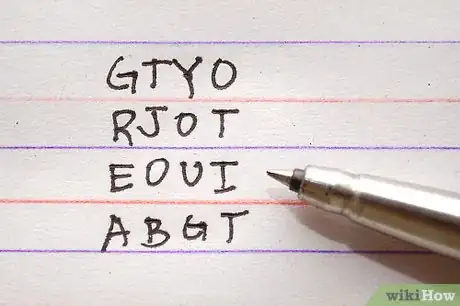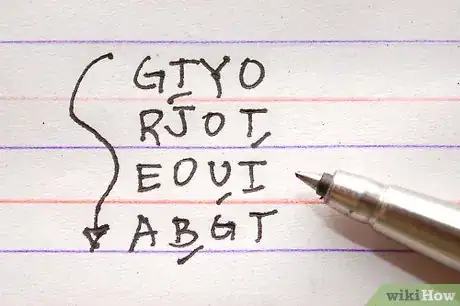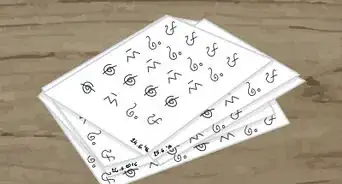wikiHow is a “wiki,” similar to Wikipedia, which means that many of our articles are co-written by multiple authors. To create this article, 35 people, some anonymous, worked to edit and improve it over time.
This article has been viewed 403,957 times.
Learn more...
Julius Caesar was one of the first people to write in code. He invented the Caesar cipher, in which each letter is replaced with another letter that's a fixed number of positions down the alphabet. The following cipher is not the Caesar cipher, but rather what cryptographers call a "columnar transposition cipher" or "Caesar's Box" though it is unclear if the code was ever actually used by Caesar.
Steps
Sample
Decoding Instructions
-
1Count the number of characters in the code. Here we have 16: G T Y O R J O T E O U I A B G T[1]
-
2Determine how many rows you can divide the letters into equally[2] (Find the square root of the number you found in step 1. If the square root isn't a whole number, round up). We can put 16 into 4 rows of 4 (I.e. the square root of 16 is 4). If we had 25 letters we could put them into 5 rows of 5 (square root of 25 is 5) and so on. In cases where the number doesn't divide so neatly, use the number of rows for the next "boxable" (perfect square) number up. The "boxable" (square) numbers are 9, 16, 25, 36, 49, etc. If the code has 22 letters (square root of 22 is 4.69), the next number up is 25, which would mean 5 rows (4.69 rounds up to 5).Advertisement
-
3Write the letters out into rows.[3] With the example given, it'd be written out as such:
GTYO
RJOT
EOUI
ABGT -
4Start from the top left letter and read down, then start at the top of the next column and read down again, and so on.[4] This example has the message: "GREAT JOB YOU GOT IT".
-
5Finished.
Community Q&A
-
QuestionHow do I write a Caesar Cypher?
 Community AnswerUsing the alphabet start by counting 3 backwards. Example, A is to X, B is to Y, C is to Z, D is to A, E is to B.
Community AnswerUsing the alphabet start by counting 3 backwards. Example, A is to X, B is to Y, C is to Z, D is to A, E is to B. -
QuestionIs a Caesar box the same as a Caesar cipher?
 Community AnswerNo. A Caesar Cipher is very simple--pick a number, N. Then substitute each letter for the letter N places in the alphabet from it. For example, if N = 3, A would become D, B would become E, etc. Note that this isn't at all secure and can be broken very easily by frequency analysis.
Community AnswerNo. A Caesar Cipher is very simple--pick a number, N. Then substitute each letter for the letter N places in the alphabet from it. For example, if N = 3, A would become D, B would become E, etc. Note that this isn't at all secure and can be broken very easily by frequency analysis. -
QuestionShould the code always be 16 characters?
 Community AnswerNo. It can be any number of characters, but the more you have, the harder it is to decode.
Community AnswerNo. It can be any number of characters, but the more you have, the harder it is to decode.
Warnings
- This code is usually not very difficult to decode. Do not put highly important information in this format.⧼thumbs_response⧽
References
About This Article
The Caesar Box code is a cipher in which each letter is replaced with another letter that’s a fixed number of positions down the alphabet. To decode one, start by counting the number of characters in the code. Then, determine the square root of that number. For example, if there are 16 characters in the code, the square root of 16 is 4. If your answer isn’t a whole number, round up. Then, write the characters out in rows, according to the square root you found. In this case, you’d write out the 16 characters in 4 rows, so there’d be 4 characters in each row. Now, starting from the top left letter in the left-hand column, read down through each column. For example, if your code was “GTYORJOTEOUIABGT,” the message would say “Great job you got it!” To see other samples of the Caesar Box code, read on!























































